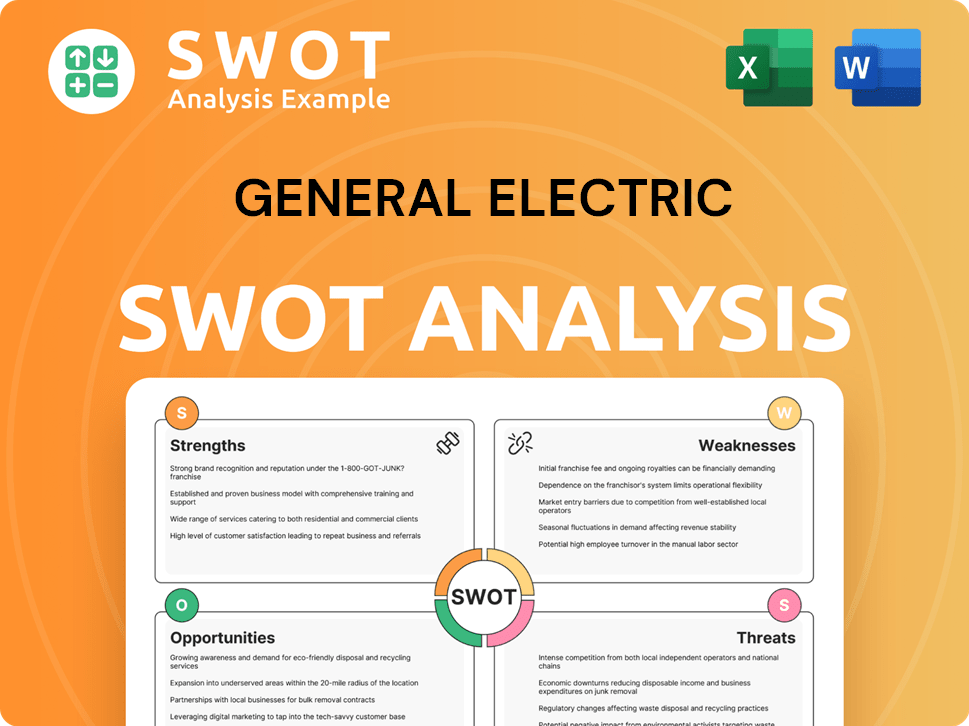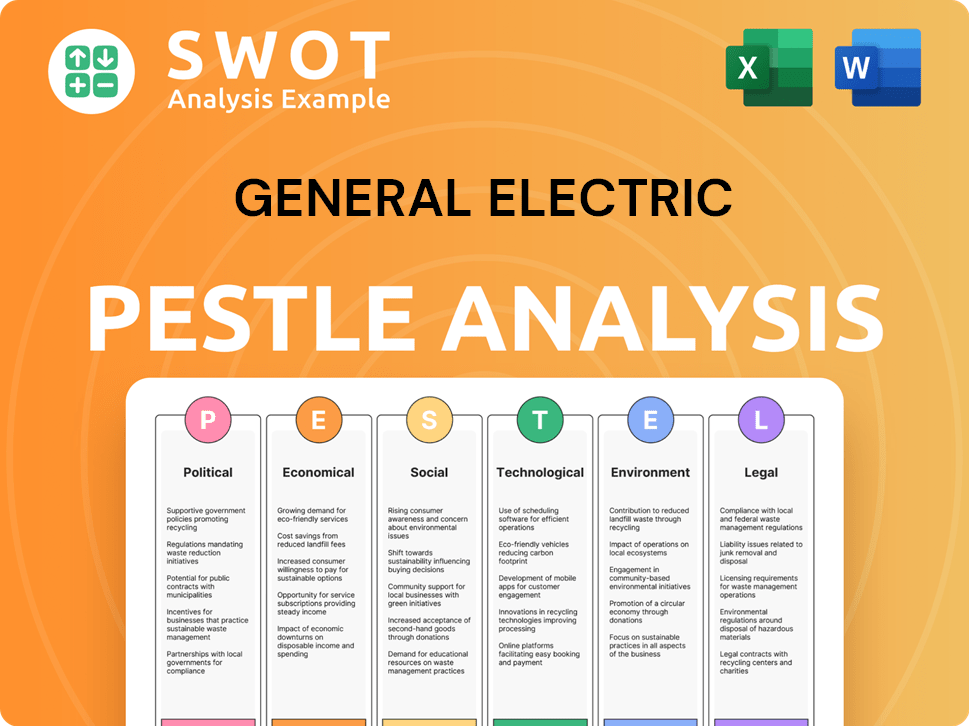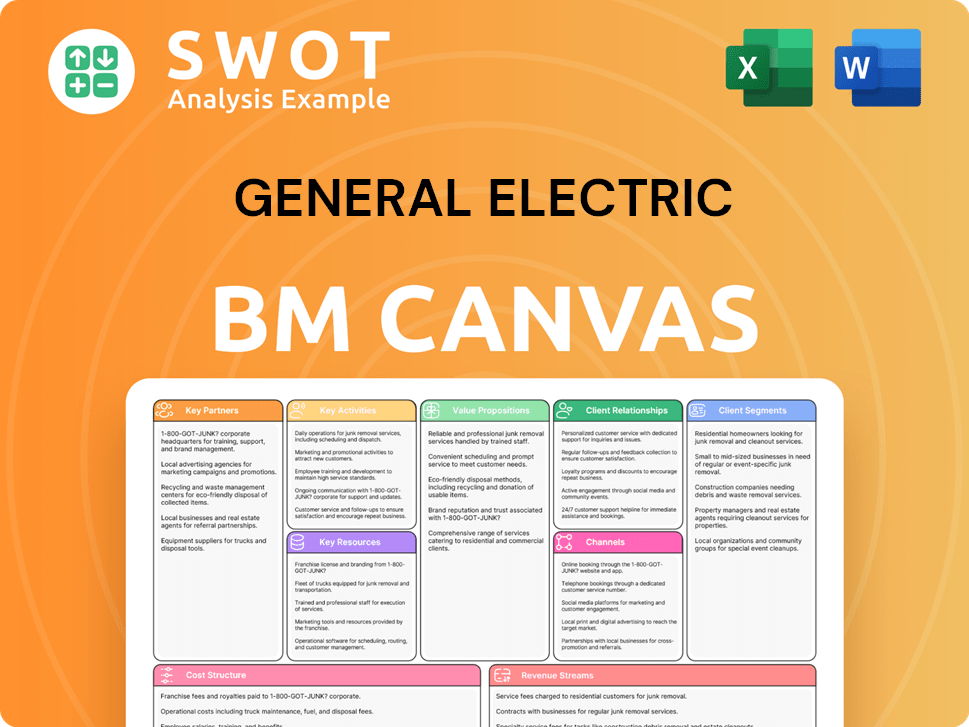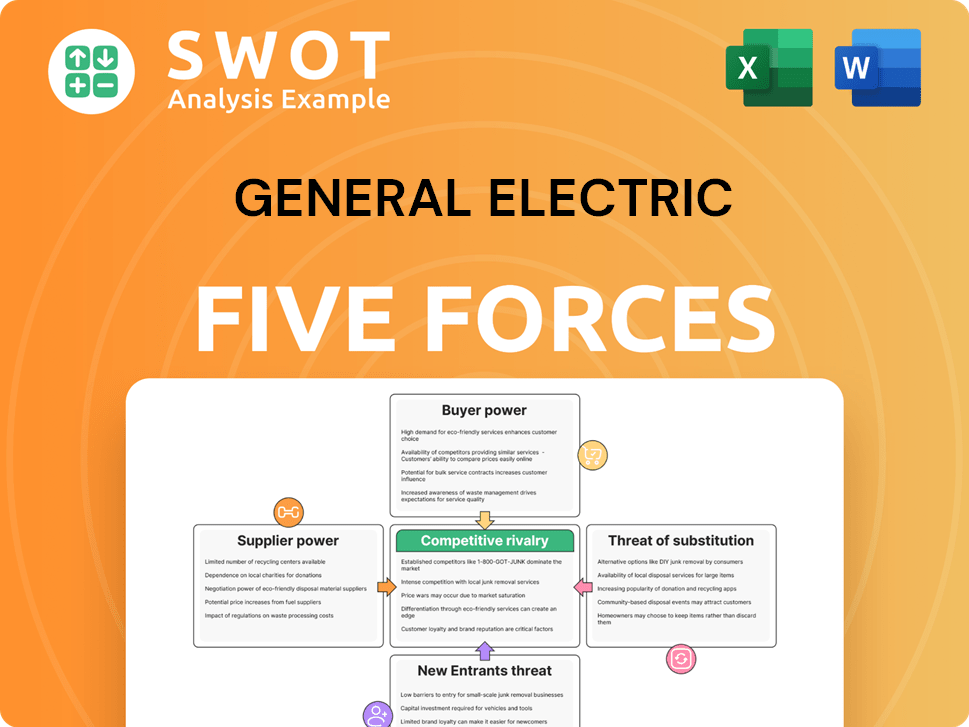General Electric Bundle
How Has GE Transformed?
General Electric (GE), a titan of American industry, has dramatically reshaped itself, emerging from its diverse past as a focused high-tech industrial leader. The 2024 restructuring split GE into three independent, publicly traded companies: GE Aerospace, GE Vernova, and GE HealthCare. This strategic move aims to unlock value by concentrating on high-growth sectors: aviation, energy, and healthcare.

This in-depth analysis explores the inner workings of the new GE, examining its core operations and financial performance. From its rich General Electric SWOT Analysis to its future potential, we'll dissect how each entity—GE Aerospace, GE Vernova, and GE HealthCare—operates within its respective industry. Discover how this evolution impacts investors and the global landscape, providing insights into the GE business model and the future of GE products.
What Are the Key Operations Driving General Electric’s Success?
The core operations of the GE Company are now structured around three independent companies, each focused on distinct sectors. This strategic realignment allows each entity to concentrate on its specific market, enhancing operational efficiency and innovation. This approach supports the delivery of specialized products and services, catering to the diverse needs of its global customer base.
Each of these companies operates with a clear value proposition, targeting specific industries and customer needs. This structure enables GE to leverage its extensive history and expertise while adapting to the evolving demands of the market. The separation aims to unlock value and drive growth through focused strategies within each sector.
The restructuring of General Electric into separate entities reflects a strategic shift towards specialized business models. This allows each company to optimize its operations, innovate more effectively, and better serve its customers. This strategic move is designed to enhance shareholder value and drive long-term sustainability across its diverse portfolio.
GE Aerospace designs, manufactures, and services aircraft engines, nacelles, and related systems. It focuses on both commercial and military aircraft, ensuring operational reliability through advanced manufacturing and a global service network. This comprehensive support system provides significant customer benefits and market differentiation.
GE Vernova is dedicated to electrifying and decarbonizing the energy system. It provides advanced technology and services for power generation, with its equipment generating approximately 25% of the world's electricity. The company focuses on delivering reliable, affordable, and sustainable energy solutions globally.
GE HealthCare specializes in healthcare technology, offering products and services from medical imaging to pharmaceutical diagnostics. It focuses on continuous innovation in diagnostics and imaging, supported by significant investment in R&D and strategic acquisitions. GE HealthCare aims to improve patient care through advanced solutions.
Each company offers a unique value proposition tailored to its market sector. GE Aerospace focuses on providing reliable and technologically advanced engines and services. GE Vernova aims to provide sustainable energy solutions, and GE HealthCare seeks to improve patient care through innovative medical technologies. These offerings are supported by robust R&D and global service networks.
The operational strategies of each GE business unit are designed to maximize efficiency and customer satisfaction. These strategies are supported by significant investments in research and development, strategic acquisitions, and global service networks. This approach ensures each company can meet its customers’ needs effectively.
- GE Aerospace focuses on advanced manufacturing and global maintenance services.
- GE Vernova emphasizes sustainable energy solutions and grid technologies.
- GE HealthCare prioritizes innovation in medical imaging and diagnostics.
- The company's history is detailed in Brief History of General Electric.
General Electric SWOT Analysis
- Complete SWOT Breakdown
- Fully Customizable
- Editable in Excel & Word
- Professional Formatting
- Investor-Ready Format

How Does General Electric Make Money?
The revenue streams and monetization strategies of the GE have been significantly reshaped following its strategic restructuring. The company, now comprised of three independent, publicly traded entities – GE Aerospace, GE Vernova, and GE HealthCare – each operates with distinct focuses and financial models. This diversification allows for specialized approaches to revenue generation and market engagement, reflecting a strategic shift towards focused business units.
Each of the three entities within the GE umbrella has its own unique approach to generating revenue. These approaches are tailored to the specific industries and markets each company serves. This structure allows for greater agility and responsiveness to the respective market dynamics, enhancing the potential for growth and profitability.
The following sections detail the revenue streams and monetization strategies of each of these independent entities, providing a comprehensive overview of their financial operations and market positions.
GE Aerospace primarily generates revenue through the sale of commercial and military aircraft engines. A significant portion of its revenue comes from aftermarket services, including maintenance, repair, and overhaul (MRO) operations. The company's financial performance is heavily influenced by the aviation industry's health and demand for aircraft engines and related services.
In Q1 2025, GE Aerospace reported total operating revenue of $9.94 billion, an 11% increase from the same period in 2024. Commercial services revenue saw a 17% increase, and equipment sales grew by 9%. For the full year 2024, the company's total revenue was $38.7 billion. The company anticipates low double-digit adjusted revenue growth for 2025, with operating profit projected between $7.8 billion and $8.2 billion.
The company focuses on maximizing revenue from engine sales and aftermarket services. This includes long-term service agreements, spare parts sales, and maintenance contracts. The ability to provide comprehensive service solutions enhances customer loyalty and ensures a recurring revenue stream. The company's success depends on its ability to innovate and meet the evolving needs of the aviation industry.
GE Vernova's revenue comes from the sale of power generation equipment, including gas and wind turbines, and associated services. The company's financial performance is tied to the global demand for energy and the transition to renewable sources. Its ability to provide efficient and reliable power solutions is critical to its success.
In 2024, GE Vernova's revenue was $34.9 billion, with a projected revenue of $36 billion to $37 billion for 2025. In Q1 2025, revenue was $8.0 billion, an 11% increase, driven by growth in both equipment and services. The company's financial projections reflect its expectations for growth in the energy sector and its ability to capitalize on market opportunities.
Monetization strategies include robust equipment growth in Power and Electrification and double-digit services growth in each segment, with positive pricing across all segments. The company focuses on expanding its services business, which provides recurring revenue and strengthens customer relationships. The company is also focused on improving the efficiency of its products and services to meet the evolving needs of the energy market.
GE HealthCare generates revenue through the sale of medical imaging equipment, pharmaceutical diagnostics, and other healthcare solutions. The company's financial performance is influenced by the healthcare industry's trends and technological advancements. The ability to provide innovative solutions is critical to its success.
- In Q1 2025, GE HealthCare reported $4.8 billion in revenue, a 3% increase from the prior year, with organic order growth of 10%.
- Imaging revenue rose 4% to $2.14 billion, and Pharmaceutical Diagnostics grew revenue 6% to $632 million in Q1 2025.
- For the full year 2024, GE HealthCare's revenue was $19.7 billion, and it forecasts organic revenue growth of 2-3% for 2025.
- Innovative monetization strategies also include data monetization through platforms like Predix, which allows industrial companies to analyze operational data to optimize operations and unlock new revenue streams.
To understand the broader context of GE's market positioning, consider the Target Market of General Electric.
General Electric PESTLE Analysis
- Covers All 6 PESTLE Categories
- No Research Needed – Save Hours of Work
- Built by Experts, Trusted by Consultants
- Instant Download, Ready to Use
- 100% Editable, Fully Customizable

Which Strategic Decisions Have Shaped General Electric’s Business Model?
A significant turning point for the GE Company was the completion of its split into three independent public companies in 2024: GE Aerospace, GE Vernova, and GE HealthCare. This strategic move was a response to challenges such as declining revenue during the COVID-19 pandemic and a broader initiative to streamline operations and focus on high-growth sectors. The split aimed to unlock value and allow each company to concentrate on its core competencies.
GE Aerospace, as the legal successor to General Electric, has shown strong financial performance. The company's competitive advantages stem from its strong brand reputation, global presence, diversified portfolio, and continuous technological innovation. GE continues to adapt to new trends and technological shifts by investing in growth and innovation, particularly in areas like hydrogen-capable turbines for GE Vernova and AI-enabled MRI technology for GE HealthCare.
GE's strategic focus on its core strengths and continuous investment in R&D are key to sustaining its business model. While facing challenges such as supply chain constraints and strong competition from companies like Siemens, Honeywell, ABB, Rolls-Royce, and Pratt & Whitney, GE is working on maintaining its market position. You can find out more about the competitive environment in the Competitors Landscape of General Electric.
The most important milestone was the split into three independent companies: GE Aerospace, GE Vernova, and GE HealthCare in 2024. This restructuring allowed each entity to focus on its specific market and operational needs. The split was a strategic response to changing market dynamics and the need for streamlined operations.
GE has made strategic moves to focus on high-growth sectors and enhance operational efficiency. This included significant investments in research and development, particularly in areas like renewable energy and healthcare technology. The company also divested from non-core businesses to streamline its portfolio.
GE's competitive edge comes from its strong brand reputation, global presence, and diversified portfolio. The company's long history of innovation, particularly in research and development, has resulted in a vast portfolio of patents. Aftermarket services and support networks also provide a significant competitive advantage.
GE Aerospace reported a 12.2% increase in operating revenue for its Aerospace segment in the first quarter of 2025 compared to 2024. The company returned over $6 billion to shareholders in 2024 and announced a further share repurchase plan of $7 billion in 2025, alongside a 30% increase in dividend.
GE is concentrating on several key areas to drive future growth and maintain its competitive edge. These include technological innovation, particularly in renewable energy, aviation, and healthcare. Strategic acquisitions and partnerships are also key to expanding its market presence and capabilities.
- Investing in renewable energy solutions, such as hydrogen-capable turbines.
- Developing AI-enabled technologies for healthcare, like advanced MRI systems.
- Expanding aftermarket services and support for aviation engines.
- Focusing on operational efficiency and cost reduction across all segments.
General Electric Business Model Canvas
- Complete 9-Block Business Model Canvas
- Effortlessly Communicate Your Business Strategy
- Investor-Ready BMC Format
- 100% Editable and Customizable
- Clear and Structured Layout

How Is General Electric Positioning Itself for Continued Success?
The GE Company, now structured into independent entities, holds strong positions within its core industries. GE Aerospace leads in aviation, benefiting from robust demand for aircraft engines and defense contracts. GE Vernova is a major player in the energy sector, and GE HealthCare maintains a strong presence in healthcare technology. As of June 2025, the combined entity had a market capitalization of $272.60 billion.
Each entity faces distinct risks. Supply chain constraints, competitive pressures, economic uncertainties, and regulatory changes pose ongoing challenges. Guidance for 2025 includes the impact of tariffs and inflation. The company's strategic initiatives focus on sustained revenue generation through innovation and targeted growth.
GE Aerospace is a leader in the aviation industry, driven by demand for aircraft engines and defense contracts. GE Vernova is a major player in the energy sector, with a focus on electrification and decarbonization. GE HealthCare maintains a strong presence in the healthcare technology market, particularly in medical imaging and diagnostics.
Supply chain constraints affect production. GE HealthCare has revised its 2025 guidance due to global trade tariffs. Competition is intense across all segments. Economic uncertainties and regulatory changes are also ongoing risks for the GE Company.
GE Aerospace expects growth in aviation and aims to expand its services business. GE Vernova is focused on sustainable energy solutions. GE HealthCare plans to continue investing in innovation. Analysts project a further rise in EPS for 2025 and 2026 for the GE.
Focus on innovation and targeted growth to sustain revenue. GE Aerospace aims to grow in the aviation sector. GE Vernova is dedicated to reliable, affordable, and sustainable energy. GE HealthCare will continue to invest in innovation, including AI-enabled MRI technology.
The separation of GE into independent entities is a significant strategic move. Each entity is focused on its core business, aiming for growth and innovation. The company's outlook for 2025 and beyond emphasizes continued growth in aviation, healthcare, and renewable energy.
- Continued growth in aviation, healthcare, and renewable energy sectors.
- Expansion of services businesses within GE Aerospace.
- Focus on sustainable energy solutions by GE Vernova.
- Ongoing innovation in healthcare technology by GE HealthCare.
General Electric Porter's Five Forces Analysis
- Covers All 5 Competitive Forces in Detail
- Structured for Consultants, Students, and Founders
- 100% Editable in Microsoft Word & Excel
- Instant Digital Download – Use Immediately
- Compatible with Mac & PC – Fully Unlocked

Related Blogs
- What are Mission Vision & Core Values of General Electric Company?
- What is Competitive Landscape of General Electric Company?
- What is Growth Strategy and Future Prospects of General Electric Company?
- What is Sales and Marketing Strategy of General Electric Company?
- What is Brief History of General Electric Company?
- Who Owns General Electric Company?
- What is Customer Demographics and Target Market of General Electric Company?
Disclaimer
All information, articles, and product details provided on this website are for general informational and educational purposes only. We do not claim any ownership over, nor do we intend to infringe upon, any trademarks, copyrights, logos, brand names, or other intellectual property mentioned or depicted on this site. Such intellectual property remains the property of its respective owners, and any references here are made solely for identification or informational purposes, without implying any affiliation, endorsement, or partnership.
We make no representations or warranties, express or implied, regarding the accuracy, completeness, or suitability of any content or products presented. Nothing on this website should be construed as legal, tax, investment, financial, medical, or other professional advice. In addition, no part of this site—including articles or product references—constitutes a solicitation, recommendation, endorsement, advertisement, or offer to buy or sell any securities, franchises, or other financial instruments, particularly in jurisdictions where such activity would be unlawful.
All content is of a general nature and may not address the specific circumstances of any individual or entity. It is not a substitute for professional advice or services. Any actions you take based on the information provided here are strictly at your own risk. You accept full responsibility for any decisions or outcomes arising from your use of this website and agree to release us from any liability in connection with your use of, or reliance upon, the content or products found herein.